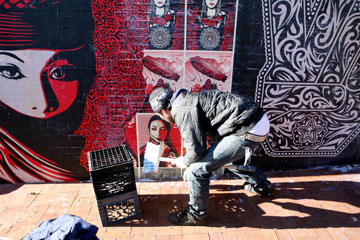Popular artist creates mural on campus

|
|
Photo by Aalok Kanani / Tufts Daily
Mitchell Geller
The Tufts Daily
World-renowned street artist Shepard Fairey left his distinctive mark at Tufts on Saturday, braving the cold weather and high winds to put up a mural on campus. The visit was part of the 2009 EPIIC International Symposium on Global Cities and coincided with the artist’s upcoming gallery show at the Institute of Contemporary Art/Boston (ICA).
Fairey, best known as the artist responsible for the Barack Obama “Hope” poster and the “Obey Giant” propaganda campaign, created the mural for a wall by the Jumbo Express convenience store, located on the lower level of the campus center. The work consists of a series of anti-war-themed images done in Fairey’s signature style, highly influenced by Communist propaganda.
The artist and five helpers, including Spencer Elden, the boy from the cover of Nirvana’s album “Nevermind” (1991), spent two and a half hours Saturday afternoon assembling the mural from a series of modular pieces of varying size. Rather than plan the mural out in its entirety, members of the crew measured the wall and pieced together a cohesive image as they went along.
Though made of paper, the mural could last for up to four years if left alone.
“It’s like everything: — it eventually goes away,” Fairey told the Daily.
Starting in February, the ICA will host Fairey’s first-ever museum survey — a solo exhibit in a major museum. The exhibit, entitled “Supply and Demand,” will run through mid-August and include nearly 20 years of work, from his early “Obey Giant” stickers to his recent Obama poster.
As part of the museum survey, Fairey is putting up a number of installations throughout Boston. The pieces will include a 60-foot banner on City Hall, a number of billboards around the city, and murals in the South End, Chinatown, the Fenway area and other neighborhoods.
Tufts is the only college in the Boston area selected to get one of the murals. It seemed like “a good spot to indoctrinate some young minds,” Fairey joked.
Actually, Sherman Teichman, the director of the Institute for Global Leadership (IGL), organized the installation. The IGL hosts the annual EPIIC Symposium.
“It enhances all of our daily lives,” Teichman said, describing the artist’s visit as bringing “the Picasso of street art to Tufts.”
Jill Medvedow, the director of the ICA and a personal friend of Teichman, approached him last week with the opportunity to have Fairey do a mural at Tufts.
Teichman jumped at the chance, and EPIIC’s Special Events Committee worked closely with administrators, who were, according to Teichman, “very excited” to get the project approved. The entire process took only a matter of days from conception
to installation.
“Tufts has been really supportive in every way,” Pedro Alonzo, co-curator of the ICA
exhibition, said.
As part of this year’s “Global Cities” theme, EPIIC, an intensive IGL class run through the Experimental College, will be exploring the phenomenon of street art. The art form is — as its supporters are quick to point out — different than graffiti.
“There is no lack of audience or following for street art,” Alonzo said. “Shepard has such an impact. Youth really identify with his work … The work is very accessible.”
Alonzo will be giving a lecture on street art at Tufts in early February as part of the EPIIC Symposium, touching not only on Fairey’s projects, but also on important work by dozens of other artists in cities around the world.
While graffiti is usually thought of as simply a name or image spray painted or scrawled on a public surface, street art is more involved. Fairey, who holds a bachelor’s degree in illustration from the Rhode Island School of Design, does most of his work with printed images affixed to surfaces either as stickers or with wheat paste, which he employed at Tufts.
On Saturday, when asked by a helper where to position a piece of the mural, Fairey replied with a grin, “All the way to the left, just like our politics.”
By the time Fairey and his crew put the finishing touches on the mural, a small crowd had assembled. As the artists stepped back from the wall to survey their work, Alonzo turned to Fairey. “Want to do another one?” he asked.
Despite having spent two hours in the whipping winds and temperatures that nearly froze the paste, Fairey answered in the affirmative. The artist, who has been gaining more recognition since his recent appearance on Comedy Central’s “The Colbert Report,” is not ready to rest on his laurels quite yet.
“There will always be the arrests and people who want to get rid of [the art], but you just have to keep going,” he said.
More Info: http://www.tuftsdaily.com/popular_artist_creates_mural_on_campus

